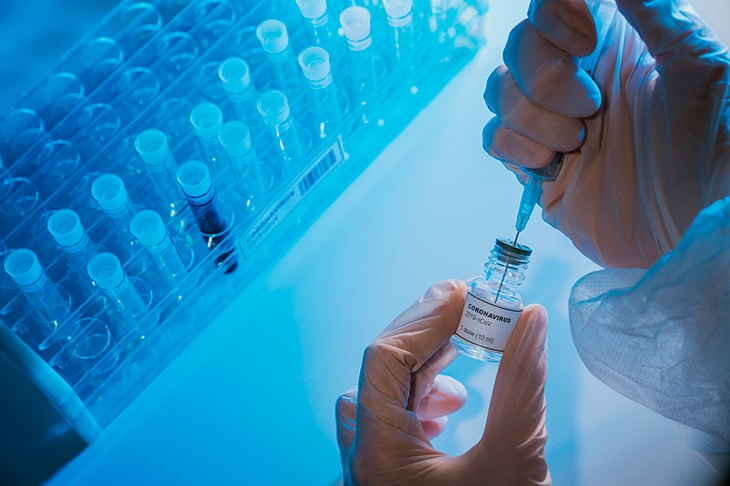Almost 60 years ago, in February 1961, two teams of scientists stumbled on a discovery at the same time. Sydney Brenner in Cambridge and Jim Watson at Harvard independently spotted that genes send short-lived RNA copies of themselves to little machines called ribosomes where they are translated into proteins. ‘Sydney got most of the credit, but I don’t mind,’ Watson sighed last week when I asked him about it. They had solved a puzzle that had held up genetics for almost a decade. The short-lived copies came to be called messenger RNAs — mRNAs – and suddenly they now promise a spectacular revolution in medicine.
The first COVID-19 vaccine given to British people this month is not just a welcome breakthrough against a grim little enemy that has defied every other weapon we have tried, from handwashing to remdesivir and lockdowns. It is also the harbinger of a new approach to medicine altogether. Synthetic messengers that reprogram our cells to mount an immune response to almost any invader, including perhaps cancer, can now be rapidly and cheaply made.
Katalin Karikó — the Hungarian-born scientist who doggedly pursued the idea behind this kind of medication for decades at the University of Pennsylvania before joining BioNTech — and her collaborator Drew Weissman may be the Watson and Brenner of this story. They figured out 15 years ago how to send a message in a bubble into a cell and have it read. For years they had tried putting in normal RNA and found it did not work; the body spotted it was an alien and destroyed it.
But by subtly modifying one of the four letters in the message (replacing uridine with pseudouridine, a chemical found in some RNAs in the body anyway), they made a version that escaped the attention of the cell’s MI5 agents. Further refinements five years ago produced a recipe that worked reliably when delivered to cells inside a tiny oily bubble. The pandemic is the first time the technique has been tried in anger, and it worked: the first two COVID vaccines, BioNTech’s and Moderna’s, rely on these messengers.
The message tells the cell to make part of one of the virus’s proteins which then alerts the body’s immune system. Once invented, the thing is like a general-purpose vaccine. You simply rewrite the message between the same opening and closing sequences, put it in the same kind of bubble, and fire it off — almost as easy for genetic engineers these days as writing a text is for teenagers. It is faster, cheaper, safer and simpler than the old ways of making vaccines.
More conventional vaccine designs may still make a vital contribution to defeating the pandemic, Oxford’s included. And the messenger method has its drawbacks, such as the need for extreme cold storage. But in the long run, messengers probably represent the future of vaccines. Now the principle has been approved by regulators, there may be no need to go through the same laborious and expensive three-phase clinical trials every time. Faced with a truly lethal pandemic — with a 10 percent mortality rate, say — the vanishingly small likelihood that a new messenger vaccine would be unsafe pales into insignificance. You could deploy it in weeks or days.
What is more, at the cost of a few billion dollars, the world may now be able to build a library of messenger vaccines for every plausible coronavirus and influenza virus with pandemic potential we can find, test them in animals and store the recipes on a hard disk, ready to go at a moment’s notice. Moderna’s vaccine was first synthesized in mid-January, before we even knew the coronavirus was coming out of China.
There are already improved variations on the messenger theme too: self-replicating messengers, for example. Vaccine development has long been the Cinderella of pharmaceuticals, and this would not have happened without the pandemic. But nor would it have happened without the 30-year scientific slog Dr Karikó undertook.
A fast, adaptable vaccine platform has long been the dream. Let’s try it against hepatitis, Zika and several kinds of common cold. We may begin to do to viruses what we have already done to most intestinal worms, many blood parasites and not a few bacteria: abolish them from the human experience. If the message is the recipe for a protein characteristic of particular tumors, the immune system may learn to mount a devastating attack on a cancer. How about Alzheimer’s?
[special_offer]
There will be setbacks, side effects and unintended consequences. There always are with innovation. There will be scares based on false fears spread by unscrupulous cranks. Already some worry that these vaccines might cause infertility. It’s nonsense, but with just enough plausibility to alarm some people. Pregnancy depends on a gene called syncytin that causes cells to fuse in the placenta. Syncytin bizarrely appears to be derived from a virus our ancestors caught millions of years ago. The spike protein, target of the Pfizer vaccine, also causes cells to fuse in a similar way. It shares with syncytin a few short sequences of letters in its gene. But so do scores of other harmless proteins in our bodies, so the worry is baseless.
One problem we will probably face if this RNA dream comes true is a rise in allergies, asthmas and autoimmune problems. These are caused by the loss of parasites which used to suppress our immune systems. The more infections we get rid of, the more likely we are to have intolerant reactions to things like pollen and gluten. But then messenger vaccines may also be a way to tackle these, and teach the immune system to behave.
What if 2020 went down in history as the year synthetic biology dealt a mortal blow to future viruses and illnesses in general, rather than the year a virus ruined our health, wellbeing and livelihoods?
This article was originally published in The Spectator’s UK magazine. Subscribe to the US edition here.

























